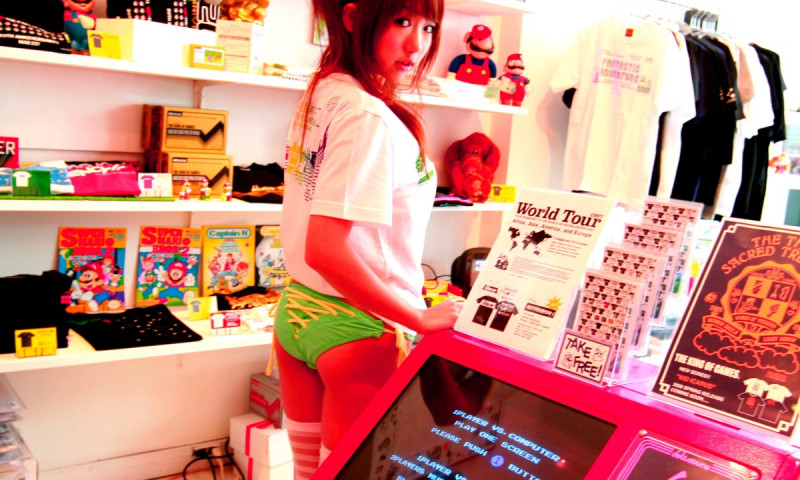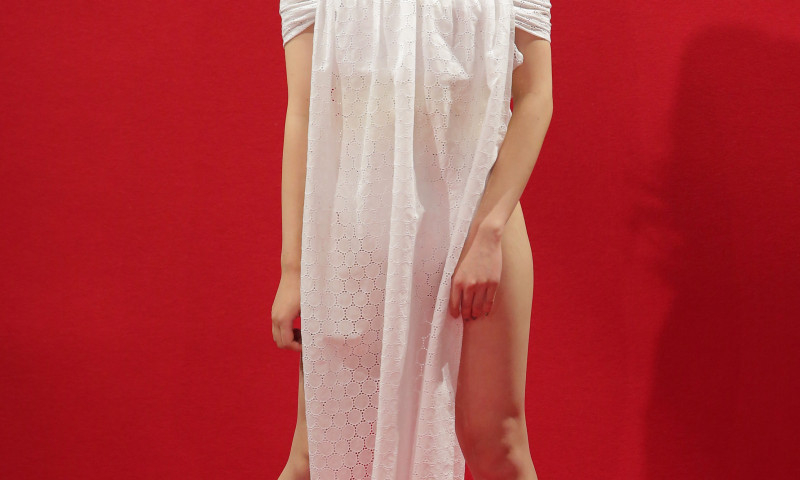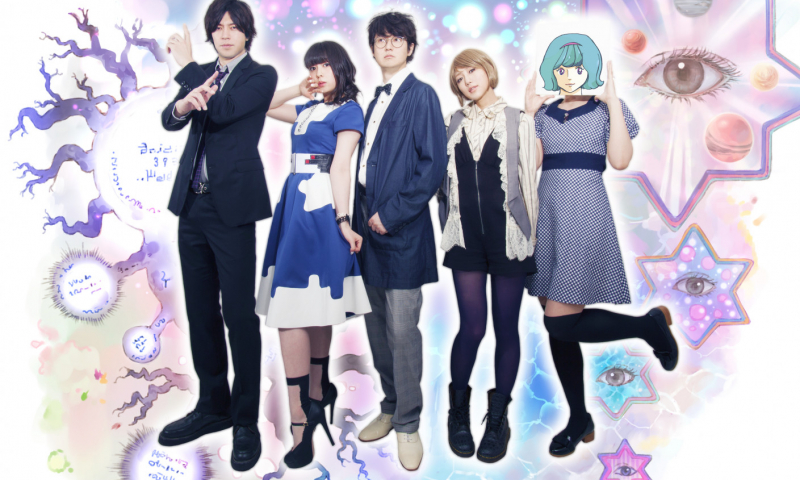
TOKYO CUTTING EDGE CREATORS by Julie Watai #11 featuring Frenesi: The Singer-Songwriting-Animator
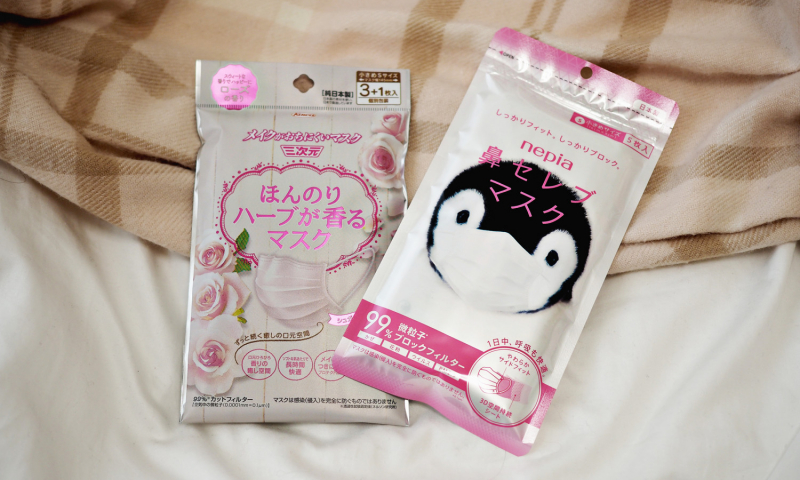
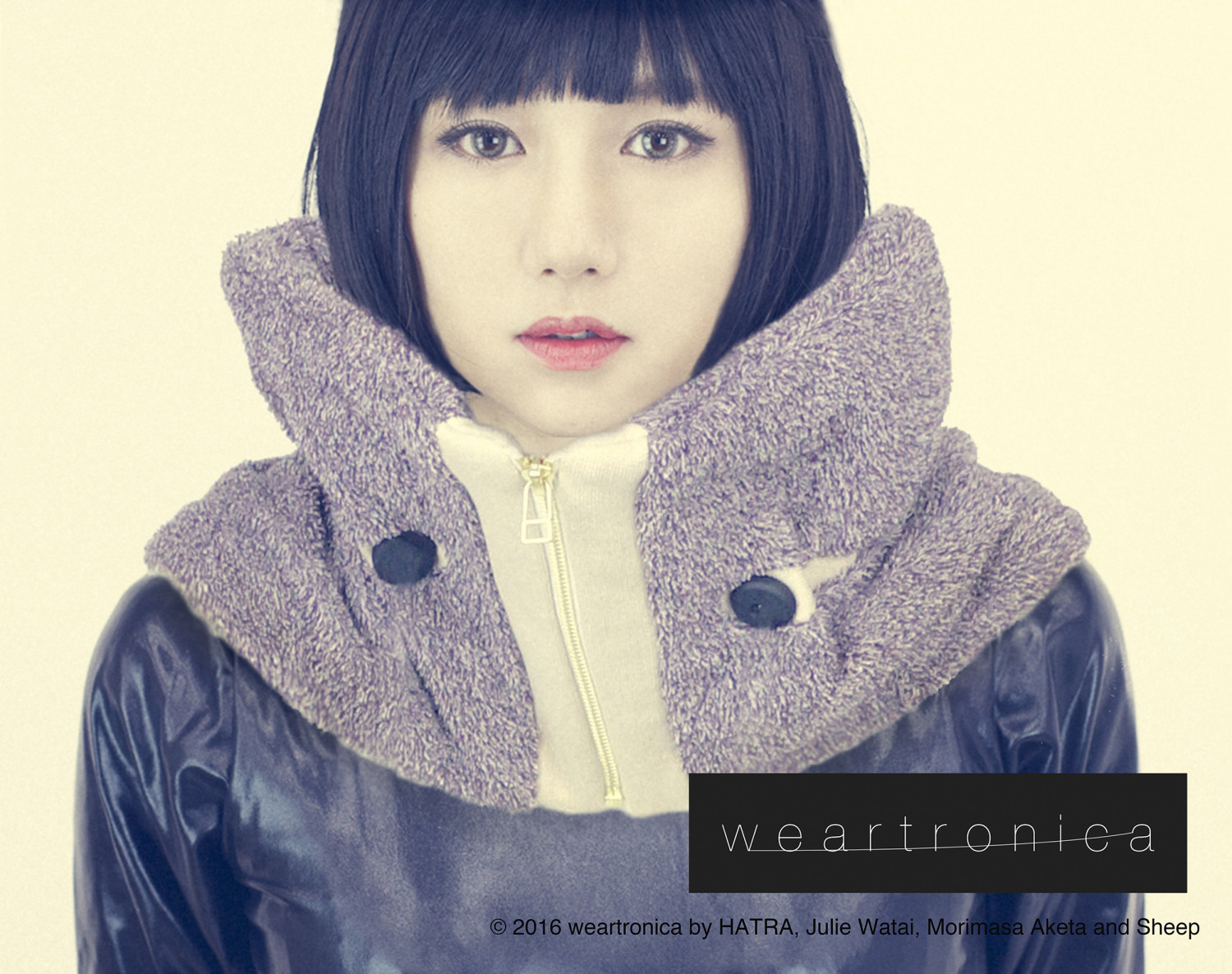
Sponsored Links
TOKYO CUTTING-EDGE CREATORS by Julie Watai is column series, which covers Tokyo’s latest cutting-edge culture! In this series she’ll be interviewing creators that have caught her interest, in order to discover the latest cutting-edge culture in Tokyo. We have interviewed Ai☆Madonna, Junya Suzuki from chloma, Etsuko Ichihara, TORIENA, Tadashi Shimaya, and Nukeme.
東京の最先端カルチャーを常に追いかけ続けているJulie Wataiさんの連載『TOKYO CUTTING-EDGE CREATORS by Julie Watai』。この連載では、Julie Wataiが注目するクリエイターとの対談を通じ、新たな東京の最先端カルチャーを発見していきます。初回では愛☆まどんなさん、第2回目ではchloma鈴木淳哉さん、第3回目では市原えつこさん、第4回ではTORIENAさん、第5回では島谷直志さん、第6回ではヌケメさんとインタビューを行いました。
For the 7th installment, we’ll be interviewing Keisuke Nagami, who has been working for fashion label “HATRA”.
そして第7回目となる今回は、ファッションレーベルHATRAの長見 佳祐さんにお話を伺いました。
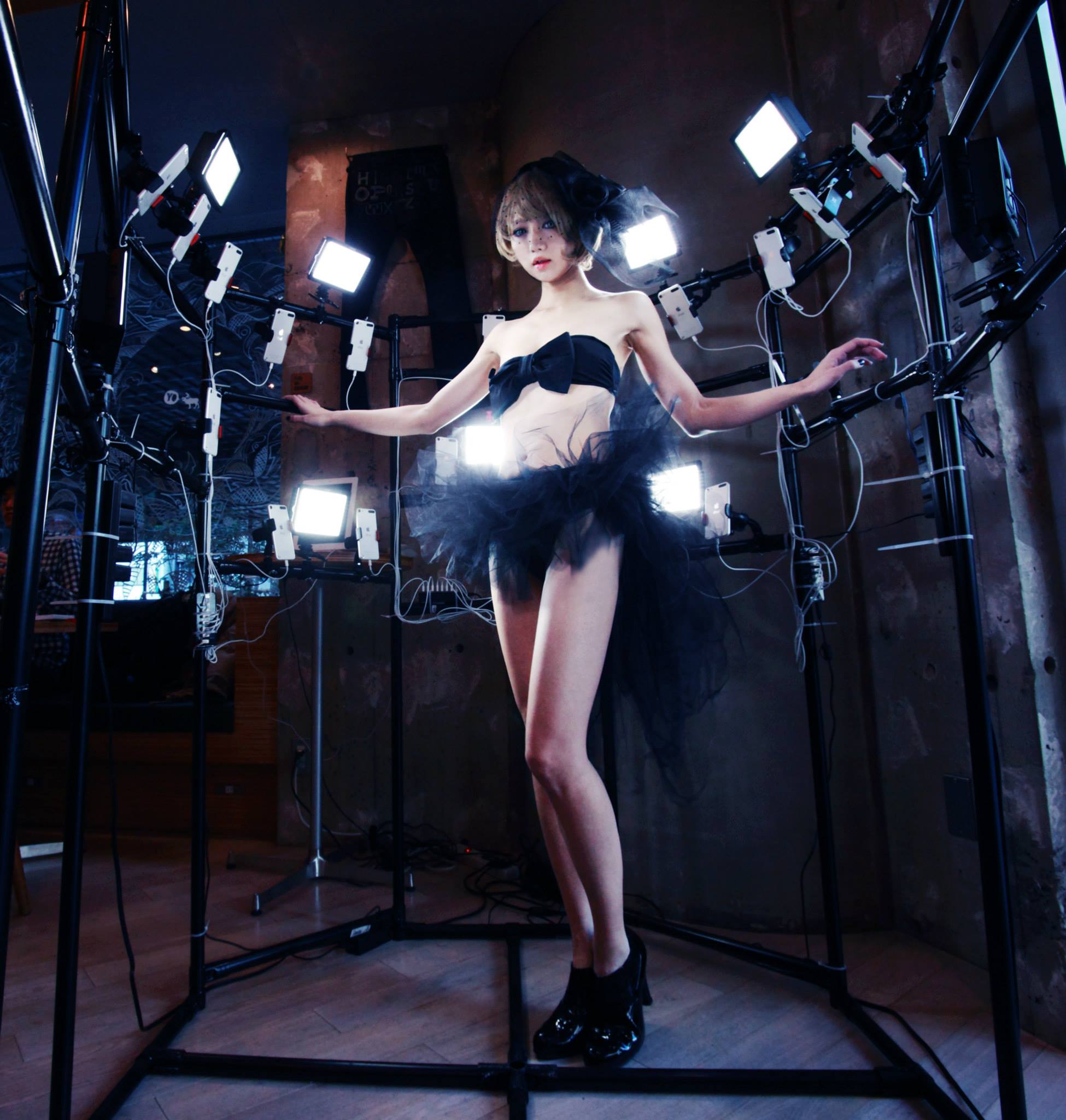
Photographer/Model : Julie Watai Shoot: Fabcafe Tokyo/3D Photo Booth (Autodesk 2013)
Julie: Nagami-san! It’s been awhile! Always at the beginning of this series I ask about what people are involved in, but once in a HATRA introductory write-up I glossed over on the net back in 2011, it said the brand’s concept “takes on the theme of allowing people who feel most comfortable at home, and even shut-ins, to feel comfortable and relaxed and to bring out this sense of comfort anywhere, in addition to proposing designs that break down 2D visions as-is into 3D ones”, and I was impressed that you were able to realize the desires of those (perhaps web designers or programmers?) who would like to wear stylish clothing- a truly original concept. Are you still currently producing clothing under this same brand concept?
Julie: 長見さん、お久しぶりです。いつも連載冒頭では活動内容をまずお伺いしているのですが、2011年頃にネットで偶然読んだHATRAの紹介文面では”家の中で居心地が良く引きこもりな生活をしていているような人でもその居心地をそのまま外に持ち出せるような心地よく安心できる服というものをテーマにしており、それに加え二次元の服の世界観をそのまま三次元に落とし込むようなデザインを提案している。”というコンセプトがあって、これは本当に斬新だし、かっこいい服を着たいそういった側の層(私のイメージだと、WEBデザイナーとかプログラマーとか?)に求められていたことが実現されているな、と感心していました。現在もブランドのコンセプトは変わらず制作をされているのでしょうか。
Keisuke: I think that way of thinking has become the foundation for our current work. With the scale of the brand expanding as it has, it’s become simpler than that. For example, frankly speaking, recently there many instances where people use words like “comfortable clothing” or “room” to describe it.
長見: 現在の活動の土台となった考え方だと思います。コンセプトはブランドの規模が広がっていくにしたがって、よりシンプルなものにまとまってきました。たとえば端的に「居心地のいい服」「部屋」といったワードで説明することが最近は多いです。
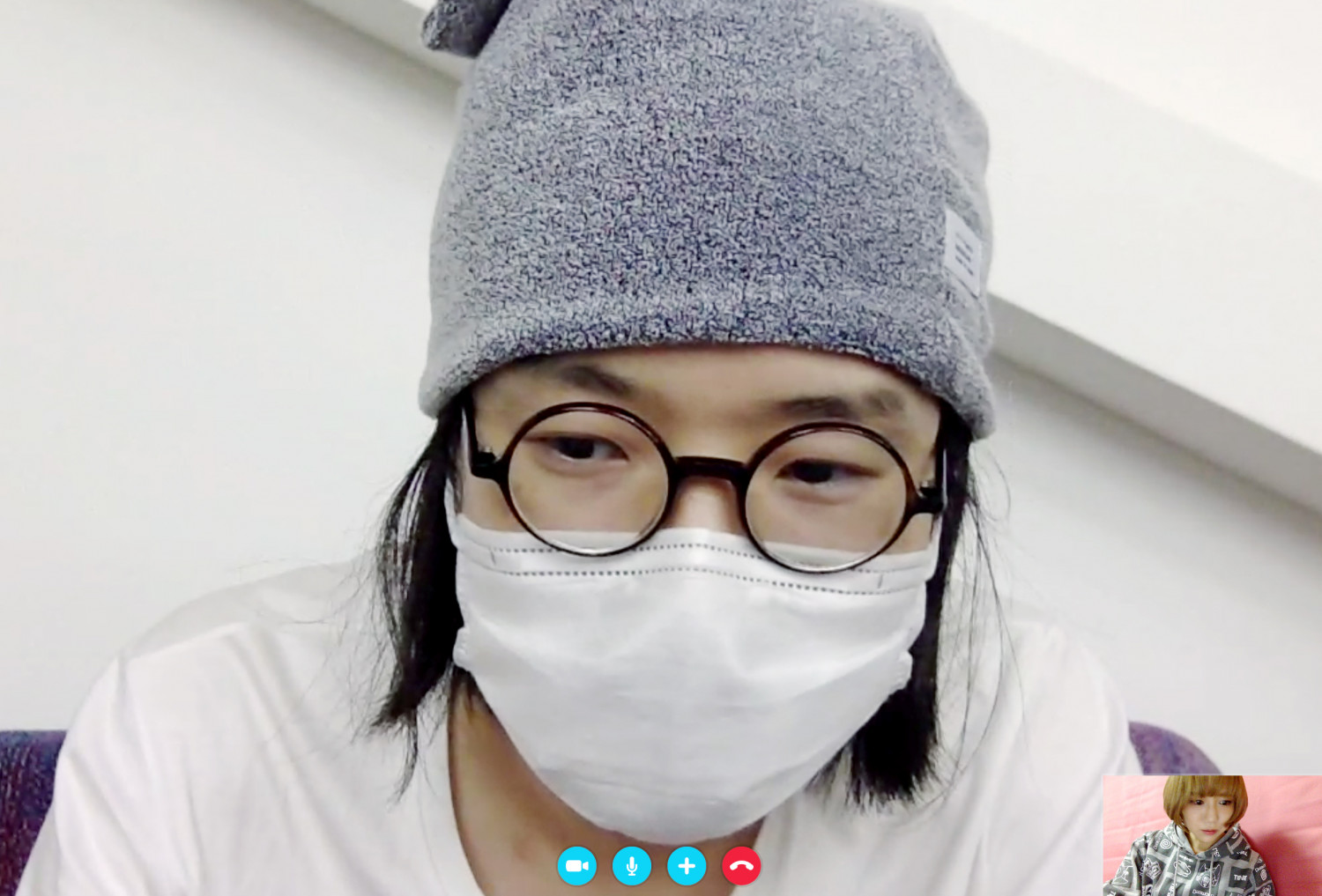
Keisuke Nagami
Julie: Although the 3D designs on HATRA’s clothing are at first eye-catching, is much attention given to the texture of it when worn, or comfort?
Julie: HATRAの服はその立体的なデザインにまず目が引かれますが、着用した時の素材感だったり、着心地にもこだわりがあるということでしょうか。
Keisuke: Of course. The 3D elements are more like a by-product. Even if we say it’s comfortable, that all depends on what the wearer is wearing it for. For instance, it won’t be long before sleepwear and mountain climbing wear designs begin sharing similarities.
長見: もちろんです。立体的な要素というのは、ハトラにおいてはむしろその副産物ですね。着心地といっても、着用者の目的によってその答えは違いますよね。たとえば寝間着と登山着のデザインが似ていくことは当分ないでしょうし。
Julie: I see, so that’s where the “room” part comes from. I saw a headline of a post online call it “a friendly brand for shut-ins”, and it was quite impressive seeing people talking about it, who, perhaps until now, had no interest in fashion.
Julie: なるほどー、だから「部屋」なんですね。ネットで「ひきこもりに優しいブランド」とも見出しをつけて投稿があったりして、多分今までファッションに興味をもてずにいたのであろう人達も話題にしているのを見て印象的だったんです。
Julie: Could you please tell me about yourself before you started HATRA?
Julie: 長見さんのHATRAを設立するまでの経歴を教えてください。
Keisuke: I was born in Hiroshima in 1987. From 2006 to 2009 I studied couture art at ESMOD Paris. Is that what you meant? (laugh)
長見: 1987年生 広島出身。2006-2009 渡仏、ESMOD Parisでクチュール技術について学ぶ。こんな感じでよいですか?(笑)
HATRA (ha-to-ra)
Keisuke Nagami’s Profile
Established HATRA in 2010. HATRA is a “room” and “comfortable clothing” unisex wear label that designs clothing to be portable private rooms.
He has a strong affinity for game and anime culture, including a number of collaboration projects with (Neon Genesis) Evangelion, which explore the possibilities of Japanese fashion.
HATRA/ハトラ
長見 佳祐さんプロフィール
2010年設立。「部屋」「居心地のいい服」を主題に掲げ、ポータブルな自室としての服をデザインするユニセックスウェア・レーベル。
ゲーム/アニメカルチャーとの親和性も高く、エヴァンゲリオン等数々のコラボレーションを経て、日本ファッションの可能性を模索する。
Julie: I see, thanks. So did you launch HATRA immediately after you graduated?
Julie: むむっ、ありがとうございます。ご卒業後すぐにHATRAを立ち上げたんでしょうか?
Keisuke: After I graduated I stayed for about another year in France, producing things and working as a trainee at Maison. I started HATRA about two months after I came back to Japan in March of 2010.
長見: 卒業後1年ほどフランスに滞在して、作品制作をしたり、メゾンで研修生として働いていたりの期間がありました。2010年3月に帰国して、HATRAが始まったのはおよそ2ヶ月後ですね。
Julie: Oh, that makes sense. When I was in Paris, I found they had Muji and UNIQLO there, and it made me wonder what French people thought about Japanese fashion. Naturally, they were simple styles with an emphasis on functionality, right?
Julie: そうだったんですね。パリに行った時、無印やUNIQLOを見かけたんですが、フランスでは日本のファッションの印象ってどんな感じなんでしょうか。やっぱり機能重視のシンプル系なんですか?
Keisuke: At the time MUJI had already settled down there to some extent, but when UNIQLO built their flagship store in the Opera district in (maybe) 2009, it may have been during a period where they were undergoing some big image changes. Actually, I think Japanese fashion must have been accepted in a way that wouldn’t tie all of its variety into one thing. Lolita fashion from Harajuku had already established itself there, and everyone knew Issei Miyake and KENZO, so there was a long line on UNIQLO’s opening day. It was probably viewed as a kind of 4D pocket (a favorite gadget of the character Doraemon), you know?
長見: 当時すでにMUJIはある程度定着していましたが、ユニクロは2009年(たぶん)にオペラ地区に旗艦店ができたりと、イメージに大きな変化があった時期かもしれませんね。実際日本のファッション、と一括りにできない多様な受け入れられ方をされていたはずです。原宿発のロリータはすでに定着していましたし、イッセイミヤケやKENZOは誰もが知っていて、ユニクロのオープン当日は長蛇の列でした。それこそ四次元ポケットのように見えていたのかもしれませんね。
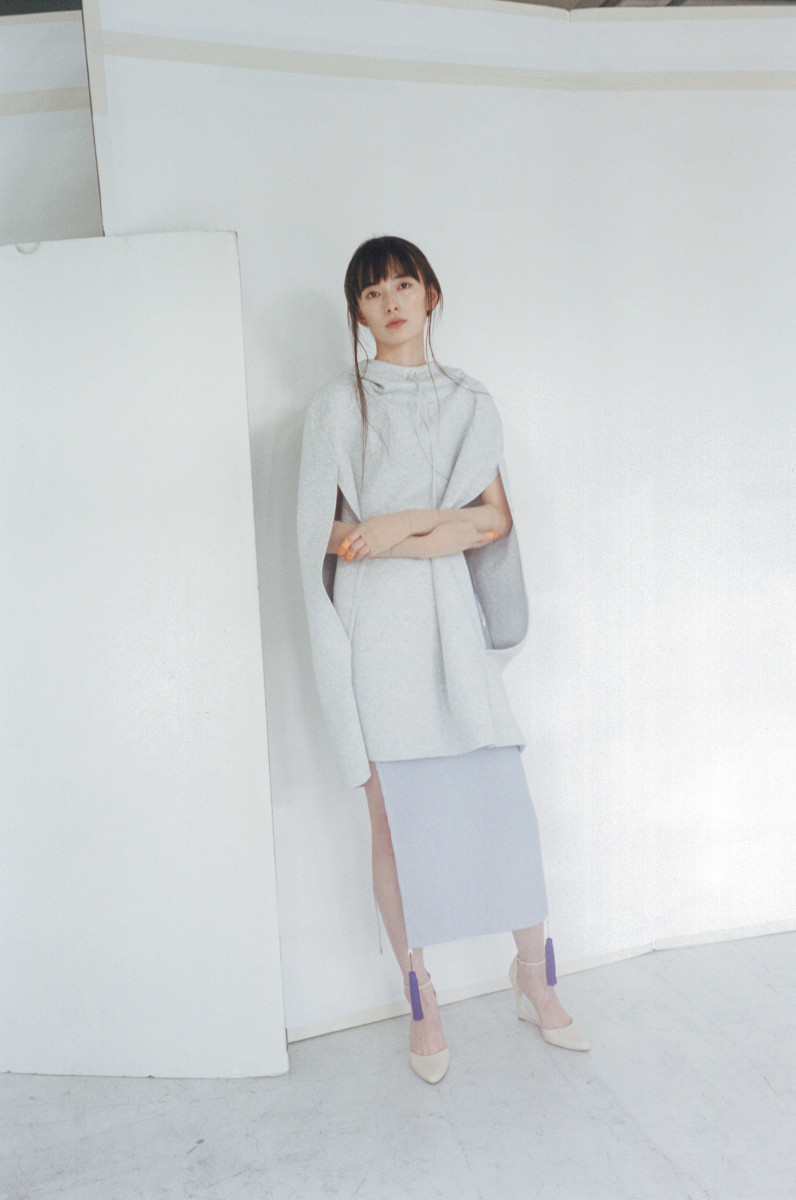
HATRA 2017 Spring/Summer Collection
Julie: I hear there are a lot of people in Paris who are interested in Japanese culture, so it makes sense that there are many who would embrace such a variation of styles. And wow! You were there such a long time (4 years)! I imagine during your time there you were able to pick up so much, but in what way in your work have you used this experience most?
Julie: パリには日本文化に興味を持っている人も多いと聞きますし、多種多様な表現が混在して受け入れられるのもなんだか納得。そして長期間(4年間!)も滞在されていたんですね。その間に培ったものが沢山あったかと思いますが、フランスで得た経験は今の長見さんの制作のどういった部分で生かされていますか?
Keisuke: Well, I only studied haute couture art for a little bit, but I think being exposed to that has become an important resource. I trained under someone who had been active in the couture world since the 1970s, and the experience I got from working under him is priceless. This person, by the way, is Japanese… (laugh) It would be a little difficult for my to explain it exactly… But without focusing on the details, it would be having the mindset to respect clothing and the body.
長見: やはりオートクチュールの技術に、少しの期間だけですが、触れられたことは大きな財産になっていると思います。1970年代からクチュールの世界で活躍されていた方に二年間師事して、その脇で得られた経験は替えがたいですね。その方日本人なんですが(笑)。具体的にどうっていう説明するのが難しいんですが・・・いろいろ端折ると、身体と衣服を敬う心です。
Julie: Although I have no background in fashion, I was just Googling haute couture. (laugh) It began in France, right? I imagine that its history, traditional techniques, and culture would have left an invaluable impact on you. Sorry to change the subject, but I’ve gotten the impression that HATRA’s support comes from younger people who work online.
Julie: ファッション属性の無い私は今しがたオートクチュールとは、でググりました(笑)。フランスで創立されたんですね。歴史と伝統のある技術や文化、意識に触れるということで変えがたい経験をされたのだなと、想像します。話は変わりますが、HATRAはインターネットを活動の拠点に据える若者達からも支持されている印象があります。
Online labels (music labels who mainly distribute online), media artists, and people like that, for example. Have you had an impact on any of these types of communities?
例えば、ネットレーベル(インターネットでの配信をメインとしている音楽レーベル)や、メディアアーティストなど。そういった界隈からの活動への影響などはあったのでしょうか。
Although it’d be impossible to reduce it to any certain genre, I often see people who are active in different online fields posting photos of themselves wearing HATRA clothing on SNS.
ジャンルでは括り切れ無いですが、様々な分野のネットで活躍する人たちがSNSにHATRAの服を着て写真投稿する現象を度々見かけます。
Keisuke: I’m glad to hear that.
長見: ありがたいですね。
Julie: You’ve been doing interesting collaboration projects one after another, too. Back in 2010 you did an exhibition with contemporary artist group Chaos*Lounge, but what led up to this collaborative project?
Julie: 興味深いコラボも次々に展開されていますよね。2010年に現代アーティスト集団「カオス*ラウンジ」との展示をされていますが、どういった経緯でコラボに至ったのでしょうか。
Keisuke: While I was in France I didn’t have any Japanese information input except on Tumblr, so after returning to Japan, I started talking with some people who had been following me there, and that led to a number of jobs. As for the collaborative project I did with Chaos*Lounge, we were at a JUNYA SUZUKI exhibition talk event together, and then they invited to their exhibition the following month. I agreed, although I had been a fan of Junya, now with chloma, and his Umelabo work since my time abroad.
長見: 在仏中Tumblr越しにしか日本の情報をインプットしていなくて、そのときフォローしていた方々と帰国後に交流ができたり仕事に繋がったことも多いです。カオス*ラウンジはとのコラボレーションはですね、「JUNYA SUZUKI」の展示内トークイベントでご一緒し、その翌月逆にカオス*ラウンジの展覧会にお誘い頂きました。ぼくも然りですが、現chlomaのジュンヤさんが在仏中から梅ラボの作品が大好きだったんですよね。
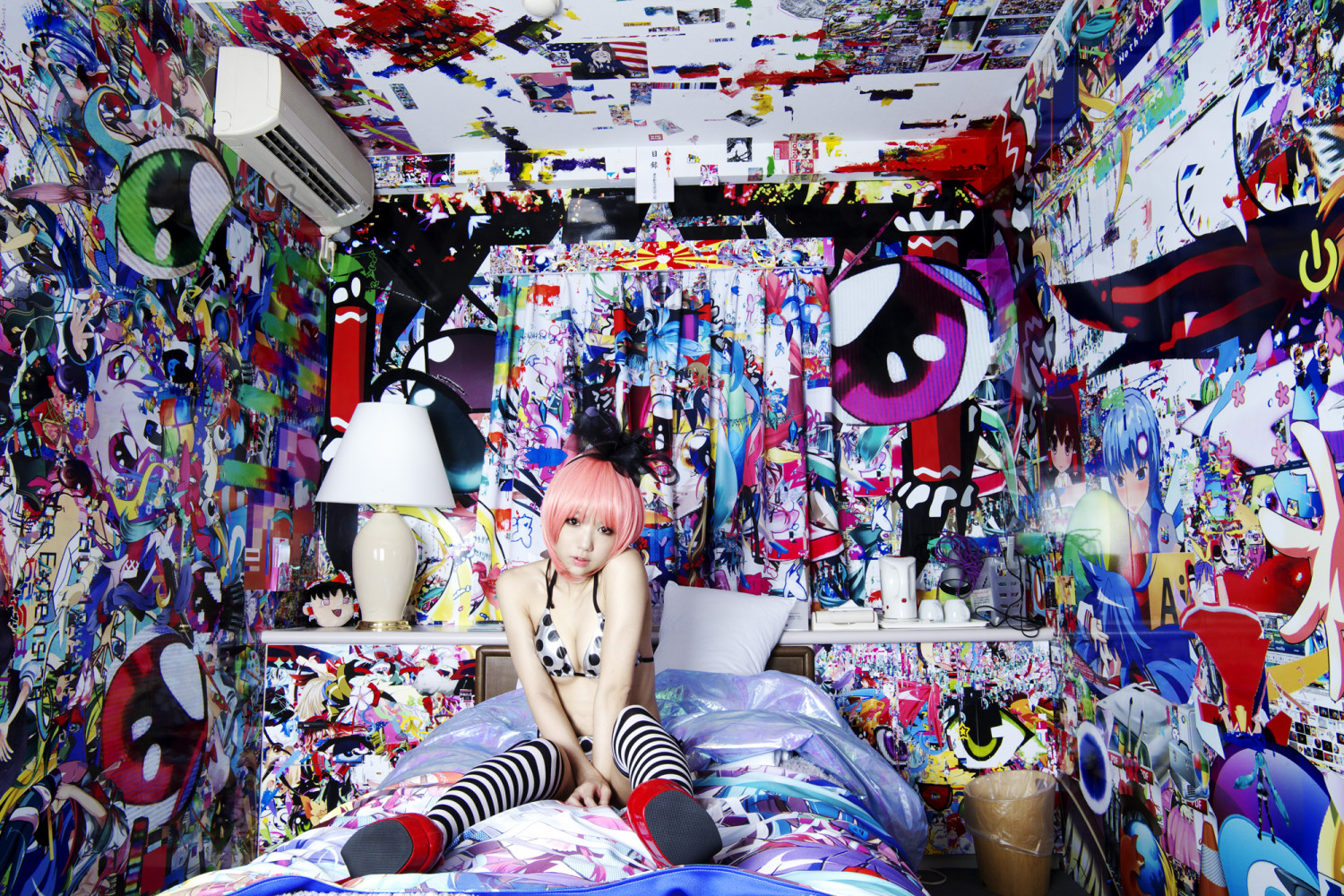
Photographer/Model: Julie Watai Background Artwork: Umelabo (Khaos*Lounge/Chaos*Sunline)
Julie: I also loved Umelabo’s work, and was shocked the first time I saw it. I was also surprised by his collaborative work with cosplayer Iiniku Ushijima! I’m well acquainted with her through shooting with them at previous events, but I hadn’t made the connection with HATRA’s look and image. Did you first talk to Ms. Ushijima?
Julie: 梅ラボさんの作品私も大好きで、最初見た時は衝撃的だったなぁ。コスプレイヤーのうしじまいい肉さんとのコラボもびっくりしました! 私も以前撮影させて貰ったりイベントでご一緒したりと面識がある方ですが、HATRAのルックのイメージとは一瞬結びつかなかったので。最初にうしじまさんからのお声掛けがあったんですか?
Keisuke: Going back to what we were previously talking about a little, most of the work I’d gotten until then had been from people who I had been a fan of. It had an unfathomable impact. You did a shoot with Ms. Ushijima? I’m surprised to hear that! For what kind of project?
長見: 話ちょっと戻りますが、これまでの仕事でご一緒した方はもともとぼくがファンだったってケースがほとんどです。影響は計り知れない。うしじまさんと撮影したんですか、びっくりですね! なんの企画ですか?
Julie: It was for an anime song club mix compilation album. This was in 2011. (http://www.crownrecord.co.jp/artist/ilovetokyo/whats.html) I decided I didn’t have anything to lose and reached out to her. Basically I thought it was going to be someone who hadn’t released anything that wasn’t self-produced. I was really glad.
Julie: アニソンのクラブミックスのコンピレーションアルバムなんです。2011年です。(http://www.crownrecord.co.jp/artist/ilovetokyo/whats.html) 私がダメ元でお声がけしたんですよ。基本的にセルフプロデュース作品以外されない方なんだろうなって思っていたので。嬉しかったですね。
Keisuke: I didn’t know that. But at about the same time, it’s not well-known, though HATRA also asked Ms. Ushijima to model for us when we were shooting our early pieces.
長見: 知らなかった。でも、ちょうどこの時期ですね、あまり知られていませんがHATRAも初期の作品撮りではうしじまさんにモデルお願いしていたんです。
Julie: Woah!! I had no idea!!
Julie: えっ!! そうだったんですね!!
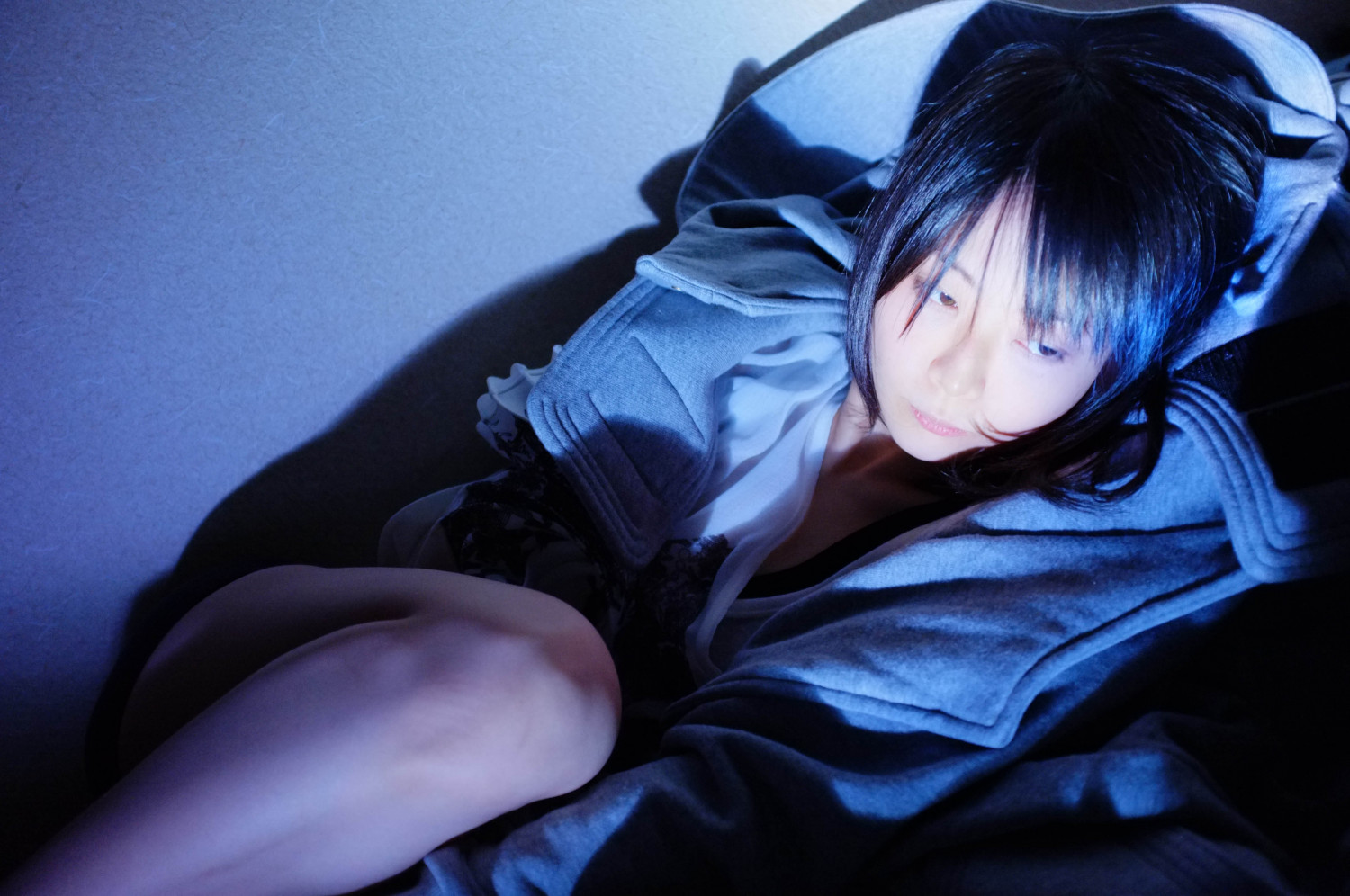
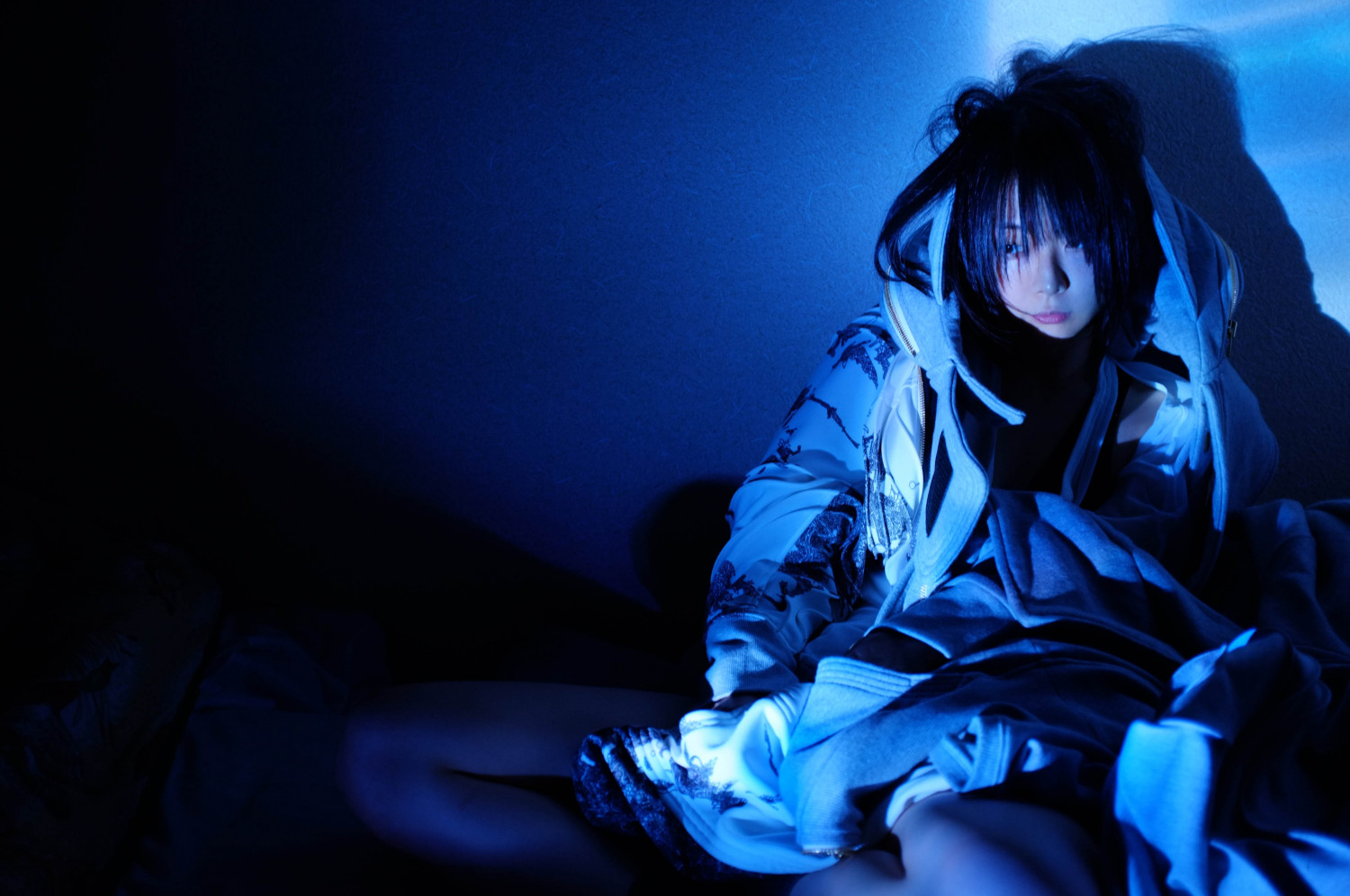
Julie: Wow. This is a really cool photo. I had no idea, but all of that led to a collaborative piece with Ms. Ushijima.
Julie: おおー。写真かっこいいですね。私は知らなかったのですが、それがうしじまさんとのコラボにつながっていたんですね。
Keisuke: But the real opportunity for that was that Chaos*Lounge event from before (laugh) Also I’ve been indebted to him since way back when, before HATRA had really taken shape; he’s been more like a lifesaver than a collaborator.
長見: それより、そもそもそのきっかけが先程のカオス*ラウンジのイベントで(笑)。まだHATRAの輪郭がぼやっとしているころからずっとお世話になっていて、コラボレーターを通り越して恩人です。
Julie: I see. During those days, it felt like people who were doing interesting things would gather at Chaos*Lounge events, and you were there. Because everyone was much older than me, I was totally fascinated by it as an outsider. (laugh)
Julie: なるほど。あの頃ネットで面白い事をやっている人たちはカオス*ラウンジ界隈のイベントに集まっている印象ありましたがそこにいらっしゃったなんて。私は世代が上なので外側からとても眩しく見ていました(笑)。
Up until now I’d known of your brand because people around me would wear HATRA hoodies, and the designs on the 2015AR “sweater point” and “scarf point” knit series you produced with illustrator Sentakki were right up my alley, so from there I started following you on Twitter.
これまで周りにHATRAのパーカーを着ている知人が何人か居たのでブランドの存在は知っていましたが、2015ARのイラストレーター“せんたっき”氏と制作したニットシリーズ「セーター点」「マフラー点」のデザインが個人的にツボで、それがきっかけでTwitterで長見さんをフォローをさせて頂きました。
At first glance the design is reminiscent of an anime character, but oddly enough when people wear it, it gives off a sophisticated feel. (Let me just say that the model is quite amazing, too. *laugh*)
一見アニメのキャラを彷彿させられるデザインなのに、人が着ると洗練された印象になるのが不思議で。(モデルさんが素晴らしいというのは置いておいて笑)。
I also felt the same way about the EVANGELION-HATRA designs, and that to combine those kinds of illustrations with fashion design really takes the kind of original knack you seem to have. Please tell me about the design’s points, if there are any.
EVANGELION-HATRAのデザインでもそう思いましたが、こういったイラストを、ファッションデザインと融合させるのって長見さんのように独自の感性が必要なんだろうなと感じたんですが。デザインのポイントがあったら教えてください。
Keisuke: I’m honored to hear that. Because it’s something you always have to be conscious about, fashion design can sometimes feel like honing in skills much like those of a translator. When you take a cool concept from one area and try to convey it in another, if the information you select is wrong, it’s conveyed in a completely misguided way, and instead of summarizing the good sense of both, they’ll run parallel to one another. So in that sense, I think it’s important to always keep a dual personality going.
長見: とても光栄です。常に意識していることでもあるのでファッションデザインはときに翻訳者のような技術が求められます。ある分野でクールな概念を、別の分野に伝えようとするとき、情報の取捨選択を間違えばまったく見当違いな伝わり方をしてしまう2つの常識を無理に集約したりせず、常に並走させること。ある意味二重人格でいられることが大事だとおもいます。
I think in Sentakki’s work, the beauty of lines and dots as fluctuations of symbols, and the pure fun of those simple components was directly conveyed as an expression of fashion.
“せんたっき”さんの作品は、線の美しさやドットによる記号のゆらめきなど、シンプルな構成要素ならではの本質的なおもしろさが、ファッション表現としてもダイレクトに伝わったのかなと思っています。
Julie: Yeah, it seems when you’re trying to express different areas, if you don’t already have a deep knowledge about each one, the completed product won’t be a cool one.
Julie: 確かに違う分野同士で表現をする場合においては、それぞれにまず前提として深い知識がないとクールなものは完成しないですね。
Despite feeling resentful towards character items like, “Whoever made this has no clue! Who would buy this?” I have many t-shirts that after purchasing them on a whim, have remained unworn.
私はキャラクター商品に対して「わかってない奴が作るからこうなるんだよ!買うかよ!」という憤りを感じつつも、原作への愛情から購入して結局一度も袖を通さなかったTシャツなど多々有ります。
Julie: Just recently in October you put on the HATRA SS17 TOKYO SHOWROOM. I’m sure it received a lot of attention, being the first collection from your new label “Okay” by the HATRA atelier team established with nukeme (who granted me an interview last time), but how did people react?
Julie: 最近ですと10月にHATRA SS17 TOKYO SHOWROOMを開催されていました。併設のnukemeさんと(前回の対談にも登場して頂きました)、HATRAのアトリエチームによるニューレーベル”Okay”の1stコレクションも注目されたと思いますが反響はいかがでしたでしょうか。
Keisuke: Well, I didn’t think the reaction was going to be that great. (laugh) It was a real accomplishment for us, but the response from our maker friends was particularly good, and I felt relieved and surprised.
長見: 反響はですね、こんなに返ってくるとは思ってなかったですね(笑)。実質的な成果もしかりですが、ものを作っている友人からの反応が特に良くて、ホッとしたり、びっくりもしたり。
Julie: I feel like nukeme has often used online culture themes to express himself, but this time the beautiful dress using stocking fabric as a drape, the loose socks dyed in dark blue and mustard colors, and the strange decorative Tanabata net design tops were all completely brand new in both idea and design!
Julie: nukemeさんというとネットカルチャーを題材に数多く表現されている印象がありましたが、今回はストッキング生地を用いたドレープの美しいドレスや、濃紺とカラシ色に染められたルーズソックス、七夕飾りの投網のような不思議なデザインのトップスなどその発想とデザインがどれも斬新すぎました!
Keisuke: The thing nukeme and I have most in common is (our hobby) Tumblr, and this time we were both able to capture that feeling of drifting off into the internet, and it felt natural that we landed here with it.
長見: ぼくとヌケメ君との一番の共通項はTumblr(趣味)で、今回もネットに漂う空気感はお互いに意識しながら制作していたら、自然とここに着地したという感じです。
Julie: Somehow it’s one the public is consciously aware of, even if the motifs aren’t connected with this particular area (of fashion), but that it blended seamlessly and magnificently into sophisticated fashion was wonderfully surreal. I’m also quite curious about nukeme’s and your Tumblr timelines. I think I’ll go take a look later.
Julie: なんとなく大衆の意識下にあるのにこの分野(ファッション)では結びつかないようなモチーフが、見事に洗練されたファッションへと昇華されているのがシュールで素敵だと思いました。そして長見さんとnukeさんのTumblrタイムラインがすごく気になってきました(笑)。あとで見にいこうと思います。

“weartronica” Image Visual Photographer/Model: Julie Watai
Julie: This past autumn you participated as a member of weartoronica, or wearable computer units, where we created a neck warmer. It was a design previously released by HATRA that we improved on by attaching mechanical parts inside.
Julie: この秋に長見さんもメンバーとして参加して貰ったウェアラブルコンピューティングのユニット「weartoronica」で制作したネックウォーマーですが、デザインはすでに販売されていたHATRAのネックウォーマーからメカニックを内部に固定するために改良をして頂きましたね。
This unit was something I’d proposed, with the internal mechanism designed by Morimasa Aketa and Hitsuji, and when I showed everyone HATRA’s design at the first meeting for this idea, everyone unanimously made a request to be involved in making it happen.
このユニットでは私は発案をさせてもらって、内部機構は明田守正さん、ひつじさんが設計しているのですが、案を出した最初の会議で私がHATRAのデザインを見せたところ満場一致で協力していただけるようなら是非お願いをしたいという運びになったんですよ。
It’s pretty common for people to get together and take part in experimental creations in the maker and tech world, but whether I’d find that same kind of enthusiasm in the fashion industry or not… It was something I was really unsure about, however as soon as I contacted you on Twitter you came to the next meeting, and it totally caught me off guard and had me thinking, “Really! Are you sure about this?!” We were really glad that you participated, but honestly, weren’t you a little worried? (laugh)
こういった試験的な制作というのはMakerやTech界隈では割と持ち寄りでよくあることなんですが、果たしてそのノリがファッション業界の方に通用するのか、、大変不安でしたが、twitterでご連絡をしてすぐ次の会議に出席してくださったので「えっ!いいの!?」てな感じで驚きました。参加してくださって我々は本当に有難かったのですが正直ちょと心配ではなかったですか?(笑)
Keisuke: Not at all; it was the best thing that could have happened. Although the deadline came at the same time as an exhibition, so that was a little severe. (laugh) Because my main work involves completing projects as part of a timeline for each season, I hardly ever make opportunities for making things outside our proposed budget. It would be fun to do more projects like that one and combine them with our main line.
長見: とんでもないです、願ってもないお話でした。納期は展示と被って少しシビアでしたが(笑)。本職では四季に合わせたタイムラインのなかでプロジェクトが進むので、なかなかこういった、予算度外視でものを作る機会が自分から作れないんです。こういったプロジェクトを重ねていくなかでメインラインと合流できればおもしろいですね。
Julie: I’m glad to hear that. I think in the near future I’ll become a field that’s more common, and I think it’d be really interesting to link what we’ve done together with it later.
Julie: ありがとうございます。近い将来は一般的になる分野だとも思いますし、今の段階でご一緒させていただけたことが後々につながれば面白いなと考えています。
Keisuke: I think that tuning unknown tech for the streets is important work, but I think the role I should be focusing on now is whatever current technology is coming out at the same time into fashion. Like turning the Google Glass into something that doesn’t feel unnatural for everyday use.
長見: 未知の技術をストリートにチューニングするのも重要な仕事だと思うんですけど、ファッションは同時に現実をテクノロジーにチューニングすることがこれからの役割だと思っています。Google Glassが不自然に感じない日常をデザインするというような。
Julie: Oh! Thinking about it in reverse is kind of like time coming to a standstill…! There will probably come a time where fashion will start bringing technology closer. Although not a machine, I wonder if ornaments prioritized by their functionality, like glasses, were treated like that at first.
Julie: あら。逆の発想で、ちょっと時間止まってしまいました・・・! ファッション側がテクノロジーに寄せていくという流れが来るのかもしれないですね。機械ではないけど、眼鏡とかそういった機能優先の装飾品も最初は世間的にそんな感じの扱われ方だったのかしら。
Keisuke: Exactly ! Like for example, if slippers were designed with roombas in mind.
長見: まさにそういうことだと思います!例えばルンバに合わせてスリッパの形が変わるとか。
Julie: Ah, I get what you’re saying! Like the environment changing to fit the standard.
Julie: ああ、なるほど! スタンダードに合わせて環境は変わりますよね。
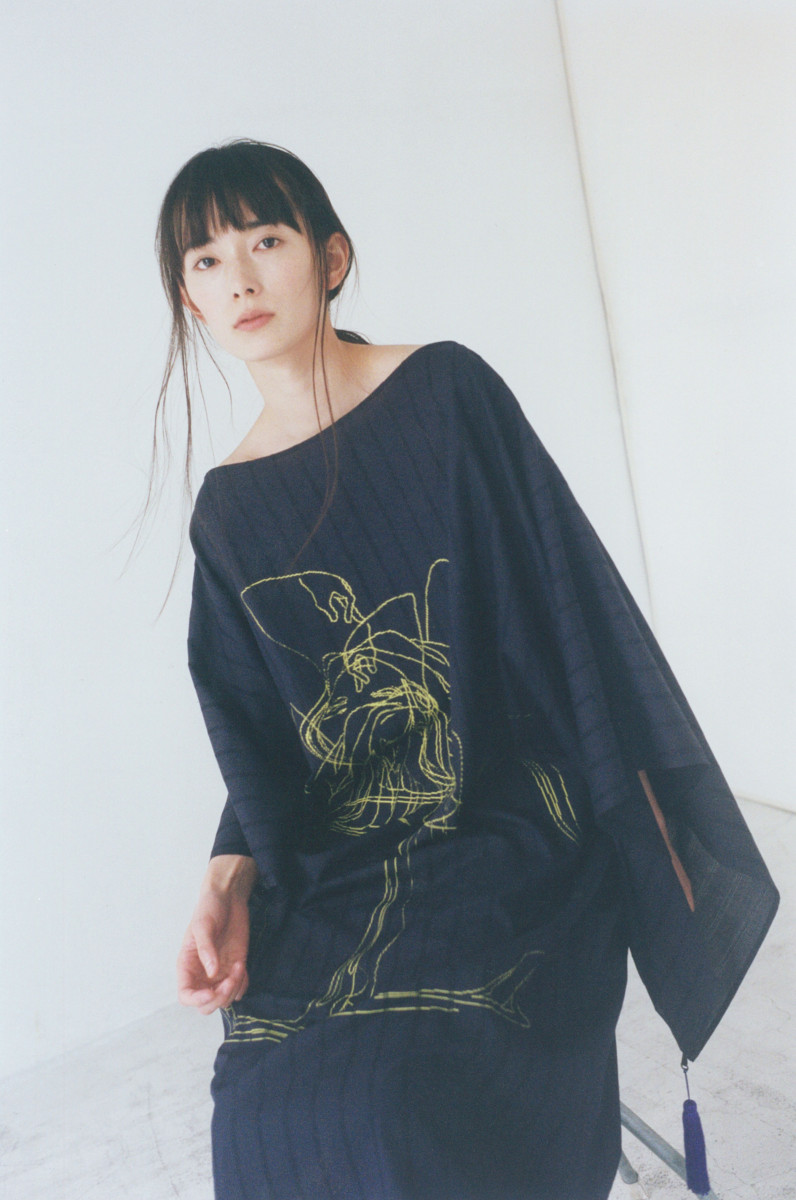
HATRA 2017 Spring/Summer Collection
Julie: For my last question, I’d like you ask you if there are any projects you’d like to take on, or about any future hopes you have.
Julie: 最後のご質問になりますが、長見さんがやってみたいプロジェクト、今後の展望などがあれば教えてもらえますか。
Keisuke: Oh wait, I thought of something I’m hopeful about! There’s a cad software made especially for apparel, called Clo3d. It can reproduce a finished, sewn product with great accuracy, based off a wallpaper’s (pattern’s) 2D data and material property information. This is an older version of it, but.
長見: あ、展望ありました! Clo3d という名前の、アパレル専用cadソフトがあります。型紙(パターン)の2Dデータと素材の物性情報をもとに縫製した完成品をかなりの精度で再現することができます。ちょっと古いバージョンですが。
Julie: I just gave it a quick click, but I had no idea there was a specific 3D software for this kind of clothing.
Julie: 今ざっと見ましたが、こんな服飾に特化した3Dソフトがあったなんて。
Keisuke: By combining it with grading (sizing) software, I’ve been thinking it would be possible to develop characters with four different proportions with the clothes people actually wear, or just different sizes, and go from there.As a continuation of a line of S, M, L sizes, I wonder if I could developing something with the same feel as MMD motion data into whatever style Miku size, for example.
長見: これとグレーディング(サイズ展開)ソフトを組み合わせれば、例えば4等身のキャラクターと人間が実際に着る服とが単なるサイズ違いとして展開することができると思っていて。S,M,Lサイズの延長線上で、例えば○○式ミクサイズも展開することがMMDのモーションデータのような感覚でできるのかなと。
At that time, I think the reality of sewn clothing will blur, and a new set of values for clothing will emerge.
そうした時に現実に縫製された服のリアリティが霞んでいって、服に対する新しい価値観が生まれてくるんじゃないかって思ってます。
Julie: If you can make that happen, it would stir up quite the revolution in the fashion industry. Is it really okay to put that kind of important idea out there on the internet? I’m a little worried for you.
Julie: それって実現したら、ファッション業界では結構革命になるんじゃ。貴重なアイデアをネットで出してしまってもいいのでしょうか。心配になってきた。
Keisuke: Ah, well I’ve talked about it before on Twitter so it’s not really an issue. (laugh) This software costs 2,000,000 yen so I don’t have my hands on it yet… But maybe by mentioning this someone will come along and help me out. (laugh) This kind of talk is something VR/AR tends to lean toward. It’s a topic that those familiar with makers have been adding their input to.
長見: あ、でもちょっと前からTwitterでは同じこと言っているので大丈夫です(笑)。このソフトが200万円するのでまだ手元になく・・・こういうこと言ってたらだれか助けてくれないかなと(笑)。この話はVR/ARとも親和性の高い話ですね。ちょっとずつメーカー関係者とお話は進んでいるんですが。
Julie: It makes me excited thinking about characters attending to me wearing clothes like that in VR/AR space.
Julie: VR/AR空間上でそのお洋服を着たキャラがアテンドしてくれたりするって考えるだけでワクワクしますね。
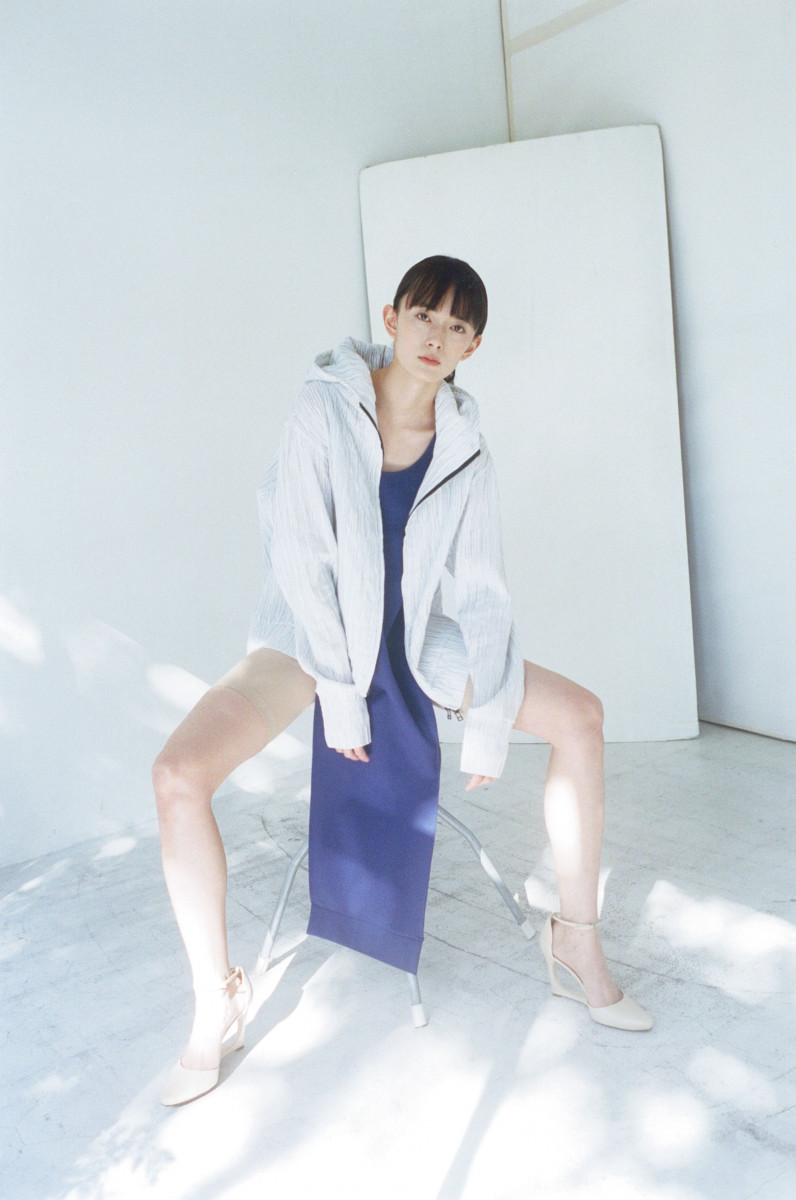
HATRA 2017 Spring/Summer Collection
After the interview/長見さんとの対談を終えて
Until now it’d been my sole impression that people working in the clothing and beauty industries were types incompatible with subculture. This is because I thought that university students who went on to industries like clearly held different perspectives from what I’d seen, and perhaps that was just the way things were back then.
これまで服飾や美容といった業種の人達はサブカルチャーと相容れない人種だと、一方的な印象を持っていた。それは学生時代にそういった業種に進む人達は明らかに違う視点を持ち合わせているからだと思って見ていたし、そういう時代だったからかもしれない。
And in fact, in order to polish their professional skills, they have to spend their days far away from the subculture scene, going through a grueling and hectic training period.
そして実際に彼らはプロとして技術を磨くために、日々サブカルチャーシーンとは縁遠い、厳しく慌ただしい修行期間を過ごさなければならない。
As a fashion brand, HATRA is held in high regards as a “respectable” maker not only a general level, but on a fan level recognized by mostly younger people. In order to push clothing expressing such a high level of creativity into the market, I figure that know-how and a strong background are important, and that Mr. Nagami must have learned that during his training period in Paris.
HATRAもファッションブランドとして一般層にも認知され若者を中心としたファン層が存在する「れっきとした」メーカー。作家性が強めに表現される服をマーケットに流通させるには、それなりの経歴とノウハウが必要になるのだろう、長見さんもパリで過ごした修行期間はそういった学びもあったのだと思う。
And currently, being raised with the insight from a mixed culture, influenced by anime, games, and the internet, this might be why its been so smoothly accepted by this era’s younger generation.
そして現在、アニメやゲーム、ネットなどのコンテンツに影響されて育ちカルチャーミックスされたその感性が、今の時代を生きる若者たちにすっと溶け込むように受け入れられているのかもしれない。
Mr. Nagami’s aspirations go beyond the realm of clothing. I could feel that his unbridled creativity in this genre is what defines HATRA’s visuality.
長見さんの話す展望は服飾の域を超えてしまっている。もはやジャンルで一括りに出来ないクリエイティティビティが収束されて、HATRAのビジュアルを形作っているのだと感じた。
Related links
HATRA website : http://hatroid.com/
Julie Watai website : http://juliewatai.jp/
Translated by Jamie Koide
Sponsored Links
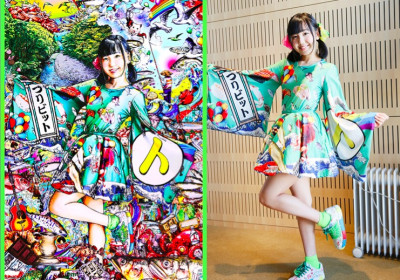
TsuriBit Ayu Konishi in IDOL GRAPHICS
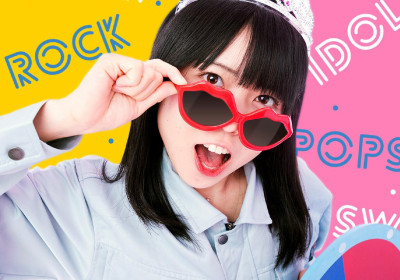
Risa Satosaki Reveals Everything in the MV for “S!NG”!


